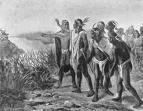One of the World's Leading
Sources of Information On Literature, the Arts, and a Wide Range of
Subjects
The City of Mexico
(This is taken from John D. Baldwin's Ancient America, originally published in 1871.)

At the city of Mexico Cortez had a great reception, negotiation having established the form of friendly relations between him and Montezuma. Quarters were provided in the city for the Spanish portion of his army, a vast edifice being set apart for their use which furnished ample accommodations for the whole force. The place could be entered only by causeways. They marched on a wide avenue which led through the heart of the city, beholding the size, architecture, and beauty of the Aztec capital with astonishment. This avenue was lined with some of the finest houses, built of a porous red stone dug from quarries in the neighborhood. The people gathered in crowds on the streets, on the flat roofs, in the doorways, and at the windows to witness the arrival of the Spaniards. Most of the streets were narrow, and had houses of a much less imposing character. The great streets went over numerous canals, on well-built bridges. Montezuma’s palace was a low, irregular pile of stone structures extending over a large space of ground.
Among the teocallis of the Aztec capital the “great temple” stood foremost. It was situated in the centre of a vast enclosure, which was surrounded by a heavy wall eight feet high, built of prepared stone. This enclosure was entered by four gateways opening on the four principal streets of the city. The “temple” was a solid structure built of earth and pebbles, and faced from top to bottom with hewn stone laid in mortar. It had five stages, each receding so as to be smaller than that below it. In general outline it was a rectangular pyramid three hundred feet square at the base, with a level summit of considerable extent, on which were two towers, and two altars where “perpetual fires” were maintained. Here the religious ceremonies were conducted. The ascent was by a circular flight of steps on the outside which went four times around the structure. The water in the lagoons being salt, the city was supplied with water by means of an aqueduct which extended to Chapultepec.
Such substantially is the account given of the old city of Mexico and its great temple by every writer who saw them before the Conquest, and all the struggles which took place for possession of this capital had a character that would have been impossible any where save in a large city. In every account of the attacks on the great temple, we can see that it was a great temple; and we may perceive what the old city was by reading any account of the desperate and bloody battles in which the Spaniards were driven from it, after standing a ten days’ siege in the great stone building they occupied.
Home | Book Collecting | Folklore / Myth | Philately | Playing Cards | Literature | Contents
